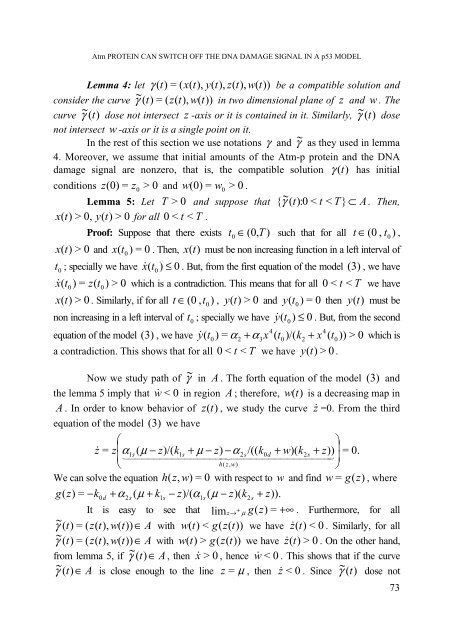biologia - Studia
biologia - Studia
biologia - Studia
You also want an ePaper? Increase the reach of your titles
YUMPU automatically turns print PDFs into web optimized ePapers that Google loves.
Atm PROTEIN CAN SWITCH OFF THE DNA DAMAGE SIGNAL IN A p53 MODEL<br />
Lemma 4: let γ ( t)<br />
= ( x(<br />
t),<br />
y(<br />
t),<br />
z(<br />
t),<br />
w(<br />
t))<br />
be a compatible solution and<br />
consider the curve<br />
~ γ ( t)<br />
= ( z(<br />
t),<br />
w(<br />
t))<br />
in two dimensional plane of z and w . The<br />
curve<br />
~ γ ( t ) dose not intersect z -axis or it is contained in it. Similarly,<br />
~ γ ( t)<br />
dose<br />
not intersect w -axis or it is a single point on it.<br />
In the rest of this section we use notations γ and ~ γ as they used in lemma<br />
4. Moreover, we assume that initial amounts of the Atm-p protein and the DNA<br />
damage signal are nonzero, that is, the compatible solution γ (t)<br />
has initial<br />
conditions z (0) = z0<br />
> 0 and w (0) = w0<br />
> 0 .<br />
Lemma 5: Let T > 0 and suppose that {γ ~<br />
( t):0 < t < T}<br />
⊂ A . Then,<br />
x ( t)<br />
> 0, y(<br />
t)<br />
> 0 for all 0 < t < T .<br />
Proof: Suppose that there exists t0 ∈ (0, T ) such that for all t ∈ (0 , t 0<br />
) ,<br />
x (t) > 0 and x ( t 0<br />
) = 0 . Then, x (t)<br />
must be non increasing function in a left interval of<br />
t ; specially we have x& ( t 0<br />
) ≤ 0 . But, from the first equation of the model (3) , we have<br />
0<br />
( t0)<br />
= z(<br />
t0<br />
x& ) > 0 which is a contradiction. This means that for all 0 < t < T we have<br />
x (t) > 0 . Similarly, if for all t ∈ (0 , t 0<br />
) , y (t) > 0 and y ( t 0<br />
) = 0 then y (t)<br />
must be<br />
non increasing in a left interval of t 0<br />
; specially we have y& ( t 0<br />
) ≤ 0 . But, from the second<br />
4<br />
4<br />
equation of the model (3) , we have y &( t0)<br />
= α<br />
2<br />
+α3x<br />
( t0)/(<br />
k2<br />
+ x ( t0))<br />
> 0 which is<br />
a contradiction. This shows that for all 0 < t < T we have y (t) > 0 .<br />
Now we study path of ~ γ in A . The forth equation of the model (3) and<br />
the lemma 5 imply that w& < 0 in region A ; therefore, w (t)<br />
is a decreasing map in<br />
A . In order to know behavior of z (t)<br />
, we study the curve z& =0. From the third<br />
equation of the model (3) we have<br />
⎛<br />
=<br />
1<br />
( )/(<br />
1<br />
)<br />
2<br />
/((<br />
0<br />
)(<br />
2<br />
)) = 0.<br />
⎟ ⎟ ⎞<br />
z&<br />
z⎜α<br />
− + − − + +<br />
⎜ 14s<br />
µ z k<br />
444444444444444<br />
s<br />
µ z α<br />
24444444444444444<br />
s<br />
k<br />
d<br />
w k<br />
s<br />
z<br />
3<br />
⎝<br />
h(<br />
z,<br />
w)<br />
⎠<br />
We can solve the equation h ( z,<br />
w)<br />
= 0 with respect to w and find w = g(<br />
z)<br />
, where<br />
g( z)<br />
= − k0d + α<br />
2s<br />
( µ + k1s<br />
− z)/(<br />
α1s<br />
( µ − z)(<br />
k2s<br />
+ z)).<br />
It is easy to see that limz →<br />
+<br />
µ g(<br />
z)<br />
= +∞ . Furthermore, for all<br />
~γ<br />
~γ<br />
( t)<br />
= ( z(<br />
t),<br />
w(<br />
t))<br />
∈ A with w ( t)<br />
< g(<br />
z(<br />
t )) we have z& (t) < 0 . Similarly, for all<br />
( t)<br />
= ( z(<br />
t),<br />
w(<br />
t))<br />
∈ A with w ( t)<br />
> g(<br />
z(<br />
t )) we have z& (t) > 0 . On the other hand,<br />
from lemma 5, if ~γ ( t)<br />
∈ A , then x& > 0 , hence w& < 0 . This shows that if the curve<br />
~γ ( t)<br />
∈ A is close enough to the line z = µ , then z& < 0 . Since<br />
~ γ ( t ) dose not<br />
73
















